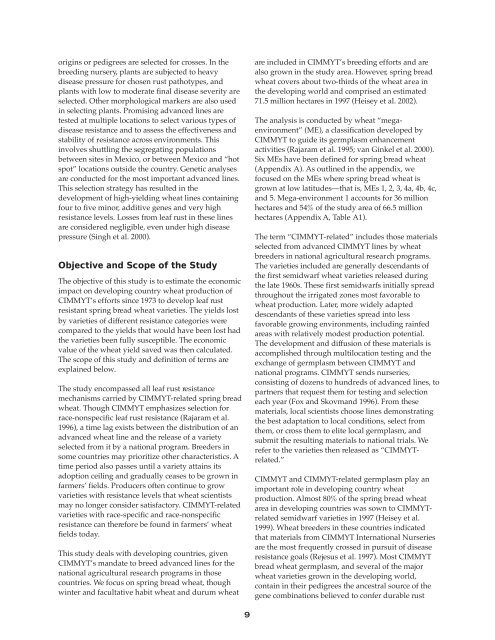The Economic Impact in Developing Countries of ... - AgEcon Search
The Economic Impact in Developing Countries of ... - AgEcon Search
The Economic Impact in Developing Countries of ... - AgEcon Search
- No tags were found...
You also want an ePaper? Increase the reach of your titles
YUMPU automatically turns print PDFs into web optimized ePapers that Google loves.
orig<strong>in</strong>s or pedigrees are selected for crosses. In thebreed<strong>in</strong>g nursery, plants are subjected to heavydisease pressure for chosen rust pathotypes, andplants with low to moderate f<strong>in</strong>al disease severity areselected. Other morphological markers are also used<strong>in</strong> select<strong>in</strong>g plants. Promis<strong>in</strong>g advanced l<strong>in</strong>es aretested at multiple locations to select various types <strong>of</strong>disease resistance and to assess the effectiveness andstability <strong>of</strong> resistance across environments. This<strong>in</strong>volves shuttl<strong>in</strong>g the segregat<strong>in</strong>g populationsbetween sites <strong>in</strong> Mexico, or between Mexico and “hotspot” locations outside the country. Genetic analysesare conducted for the most important advanced l<strong>in</strong>es.This selection strategy has resulted <strong>in</strong> thedevelopment <strong>of</strong> high-yield<strong>in</strong>g wheat l<strong>in</strong>es conta<strong>in</strong><strong>in</strong>gfour to five m<strong>in</strong>or, additive genes and very highresistance levels. Losses from leaf rust <strong>in</strong> these l<strong>in</strong>esare considered negligible, even under high diseasepressure (S<strong>in</strong>gh et al. 2000).Objective and Scope <strong>of</strong> the Study<strong>The</strong> objective <strong>of</strong> this study is to estimate the economicimpact on develop<strong>in</strong>g country wheat production <strong>of</strong>CIMMYT’s efforts s<strong>in</strong>ce 1973 to develop leaf rustresistant spr<strong>in</strong>g bread wheat varieties. <strong>The</strong> yields lostby varieties <strong>of</strong> different resistance categories werecompared to the yields that would have been lost hadthe varieties been fully susceptible. <strong>The</strong> economicvalue <strong>of</strong> the wheat yield saved was then calculated.<strong>The</strong> scope <strong>of</strong> this study and def<strong>in</strong>ition <strong>of</strong> terms areexpla<strong>in</strong>ed below.<strong>The</strong> study encompassed all leaf rust resistancemechanisms carried by CIMMYT-related spr<strong>in</strong>g breadwheat. Though CIMMYT emphasizes selection forrace-nonspecific leaf rust resistance (Rajaram et al.1996), a time lag exists between the distribution <strong>of</strong> anadvanced wheat l<strong>in</strong>e and the release <strong>of</strong> a varietyselected from it by a national program. Breeders <strong>in</strong>some countries may prioritize other characteristics. Atime period also passes until a variety atta<strong>in</strong>s itsadoption ceil<strong>in</strong>g and gradually ceases to be grown <strong>in</strong>farmers’ fields. Producers <strong>of</strong>ten cont<strong>in</strong>ue to growvarieties with resistance levels that wheat scientistsmay no longer consider satisfactory. CIMMYT-relatedvarieties with race-specific and race-nonspecificresistance can therefore be found <strong>in</strong> farmers’ wheatfields today.This study deals with develop<strong>in</strong>g countries, givenCIMMYT’s mandate to breed advanced l<strong>in</strong>es for thenational agricultural research programs <strong>in</strong> thosecountries. We focus on spr<strong>in</strong>g bread wheat, thoughw<strong>in</strong>ter and facultative habit wheat and durum wheatare <strong>in</strong>cluded <strong>in</strong> CIMMYT’s breed<strong>in</strong>g efforts and arealso grown <strong>in</strong> the study area. However, spr<strong>in</strong>g breadwheat covers about two-thirds <strong>of</strong> the wheat area <strong>in</strong>the develop<strong>in</strong>g world and comprised an estimated71.5 million hectares <strong>in</strong> 1997 (Heisey et al. 2002).<strong>The</strong> analysis is conducted by wheat “megaenvironment”(ME), a classification developed byCIMMYT to guide its germplasm enhancementactivities (Rajaram et al. 1995; van G<strong>in</strong>kel et al. 2000).Six MEs have been def<strong>in</strong>ed for spr<strong>in</strong>g bread wheat(Appendix A). As outl<strong>in</strong>ed <strong>in</strong> the appendix, wefocused on the MEs where spr<strong>in</strong>g bread wheat isgrown at low latitudes—that is, MEs 1, 2, 3, 4a, 4b, 4c,and 5. Mega-environment 1 accounts for 36 millionhectares and 54% <strong>of</strong> the study area <strong>of</strong> 66.5 millionhectares (Appendix A, Table A1).<strong>The</strong> term “CIMMYT-related” <strong>in</strong>cludes those materialsselected from advanced CIMMYT l<strong>in</strong>es by wheatbreeders <strong>in</strong> national agricultural research programs.<strong>The</strong> varieties <strong>in</strong>cluded are generally descendants <strong>of</strong>the first semidwarf wheat varieties released dur<strong>in</strong>gthe late 1960s. <strong>The</strong>se first semidwarfs <strong>in</strong>itially spreadthroughout the irrigated zones most favorable towheat production. Later, more widely adapteddescendants <strong>of</strong> these varieties spread <strong>in</strong>to lessfavorable grow<strong>in</strong>g environments, <strong>in</strong>clud<strong>in</strong>g ra<strong>in</strong>fedareas with relatively modest production potential.<strong>The</strong> development and diffusion <strong>of</strong> these materials isaccomplished through multilocation test<strong>in</strong>g and theexchange <strong>of</strong> germplasm between CIMMYT andnational programs. CIMMYT sends nurseries,consist<strong>in</strong>g <strong>of</strong> dozens to hundreds <strong>of</strong> advanced l<strong>in</strong>es, topartners that request them for test<strong>in</strong>g and selectioneach year (Fox and Skovmand 1996). From thesematerials, local scientists choose l<strong>in</strong>es demonstrat<strong>in</strong>gthe best adaptation to local conditions, select fromthem, or cross them to elite local germplasm, andsubmit the result<strong>in</strong>g materials to national trials. Werefer to the varieties then released as “CIMMYTrelated.”CIMMYT and CIMMYT-related germplasm play animportant role <strong>in</strong> develop<strong>in</strong>g country wheatproduction. Almost 80% <strong>of</strong> the spr<strong>in</strong>g bread wheatarea <strong>in</strong> develop<strong>in</strong>g countries was sown to CIMMYTrelatedsemidwarf varieties <strong>in</strong> 1997 (Heisey et al.1999). Wheat breeders <strong>in</strong> these countries <strong>in</strong>dicatedthat materials from CIMMYT International Nurseriesare the most frequently crossed <strong>in</strong> pursuit <strong>of</strong> diseaseresistance goals (Rejesus et al. 1997). Most CIMMYTbread wheat germplasm, and several <strong>of</strong> the majorwheat varieties grown <strong>in</strong> the develop<strong>in</strong>g world,conta<strong>in</strong> <strong>in</strong> their pedigrees the ancestral source <strong>of</strong> thegene comb<strong>in</strong>ations believed to confer durable rust9
















